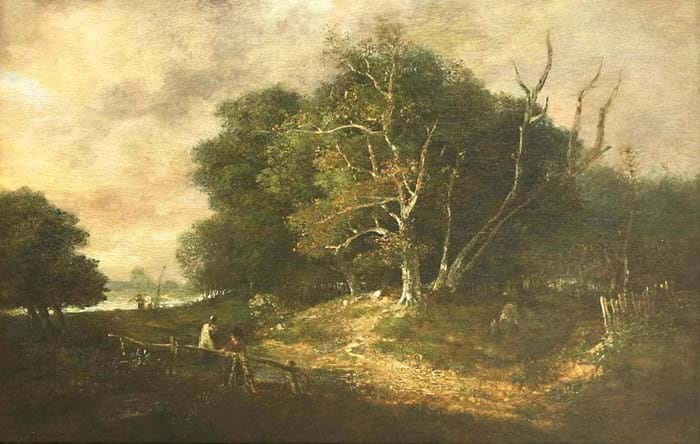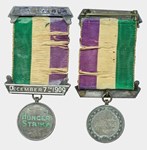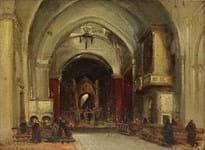
The group of early 19th century painters and watercolourists now known as the first generation of Norwich School artists retains an active market, even though the supply of fresh material is not what it once was.
With a knowledgeable and well-off collecting base, when quality works have appeared in the last 20 years they have tended to perform well in the context of the general market for traditional English pictures. The problem for auctioneers and dealers is getting these works in the first place.
While the odd example does appear from time to time, a decent-sized group of market-fresh works offered from a single owner is a significant rarity.
Good collection
A good collection of pictures by Norwich School favourites did appear, however, at Sworders (25% buyer’s premium) of Stansted Mountfitchet on December 8-9, courtesy of the family of Surgeon Vice Admiral Sir Godfrey Milton- Thompson (1930-2012).
The highly distinguished physician and naval officer, who pioneered the first effective treatment of the peptic ulcer, a long-standing scourge of sailors, featured 23 lots by artists such as John Crome, John Sell Cotman, James Stark, Robert Ladbrooke and George Vincent.
The consignment raised a total of just over £42,000 and generally performed well, although a marked difference was noticeable between a small number of highlights that brought notable competition and more muted demand for less-than-stellar material. You could say it summed up the wider market for such pictures currently: it was a case of the best and the rest.
While today’s market might be selective, this has not always been the case. Indeed, the fortunes of Norwich School have ebbed and flowed over the long term.
Georgian Norwich is said to have produced more successful artists than any other city in England (apart from London), with the Norwich Society of Artists, founded by Crome and Ladbrooke in 1803, holding regular exhibitions for more than 30 years. Patrons included many wealthy Norwich families – such as the Gurney banking family who founded the forerunner of Barclays.
Originally regarded as modern and progressive, by the end of the 19th century the movement was seen as belonging to a bygone age. Although a Royal Academy exhibition in 1878 brought them back to some attention, it was only really in 1970-80s that a revival of interest in 19th century British art helped its reputation blossom again.
Reasonably estimated
The estimates of the works at Sworders were seemingly an acknowledgement of the selectivity that has risen in this sector over the decades since. Sarah Flynn, head of Old Master paintings at the firm, said: “We had priced these on the whole very reasonably for the very reason that, of late, this area of the market has not been as buoyant as it once was.”
But noting the “focused interest” the collection received from Norwich School collectors, she pointed out that the top works all drew demand taking them well beyond expectations.
“It is encouraging to know that when works come fresh to the market, even when they are considered to be a bit out of fashion, there are still those collectors that are interested and prepared to dig deep into their pockets when necessary.”
This was especially the case with a river landscape by John Sell Cotman (1782-1842). “Genuine works by the artist don’t often come on the market and this picture had a good provenance and exhibition history,” said Flynn. “However, we had not anticipated it would draw as much interest as it did.”
The 17 x 14in (43 x 36cm) oil on canvas had once been owned by Gavin Astor and kept in Hever Castle. It had later been bought by Milton-Thompson at Christie’s in April 1991 for £12,000.
Since the Second World War, it had appeared at two British Council exhibitions as well as at a loan show at London dealer Thomas Agnew & Sons, where its title was given as Salmon Spearing.
The fact that it was an oil painting with an attractive subject of an angler and his dog near a bridge, made it something of a rarity – most works by Cotman that appear at auction are watercolours of landscapes or ruined buildings. The condition was reasonable, despite some cracking to the sky and scattered areas of overpaint.
With these factors in its favour, the £2000-3000 estimate made it a highly attractive prospect and it sold for £14,200 to a local private collector bidding online.
While the picture may have declined in value somewhat since the 1991 sale (accounting for inflation), it was the highest price for the artist since an early watercolour (catalogued as ‘circle of’) made £20,000 at Mellors & Kirk in September 2018.
Crome trio
Prolonged bidding also emerged for the pick of three works by John Crome (1769-1821). The artist, who lived in East Anglia all his life and is sometimes referred to as ‘Old Crome’ (to distinguish him from his artist son John Bernay Crome), is regarded as the principal father of the Norwich School.
The view of a thatched farmhouse by paddock rails was a 17¼ x 21¼in (44 x 54.5cm) oil on millboard that was estimated at what proved to be an undercooked £400-600.
Date is important when it comes to the Norwich School and this picture had been exhibited at an early show of the Norwich Society of Artists in 1805. It also had a long provenance going back to the Pre-Raphaelite sculptor Thomas Woolner and had been acquired by Milton-Thompson following its sale at Christie’s in October 1986. Again, it had some overpaint but its condition was generally sound.
Eventually sold for £10,400 to an online buyer, it made the fourth-highest price for Crome and the highest for well over a decade.
Later work
Showing the selectivity present in the market, however, a later work by the artist from 1814 depicting farmhands in a tree-lined lane near Beccles, Suffolk, sold for £650 against a £300-500 estimate. The 10¾ x 15¾in (27 x 40cm) oil on panel was one of more than 100 works that formed the John Crome Memorial Exhibition held in November 1821 by the Norwich Society of Artists (held six months after the artist died).
Milton-Thompson had bought it at Christie’s South Kensington in 1985 but the fact that it was broadly similar to many other landscapes by the artist probably limited demand. The abundant supply of such works allows buyers to be picky.
Overall, the two-day Sworders sale raised £962,470 including premium, with the 261-lot picture section contributing £397,180. Around 75% of the lots sold.
Constable authenticated
By far and away the top lot was the newly identified Dedham Vale with Brantham mill and haystacks by John Constable (1776-1837), pictured in News, ATG No 2469.
Having previously been in a collection hung in a London townhouse for many years but dismissed as a copy, it had been recently authenticated by the art historian and Constable expert Anne Lyles as a view of the Suffolk landscape that included a windmill owned by his father.
It was estimated at £100,000-150,000 but was knocked down at £70,000 to a private buyer.
The lack of bidding appears to have been on account of a series of condition issues. The board was rather fragile, it had a number of old tears visible at the top and bottom, and some of the retouching was described in the catalogue as ‘slightly mismatched to the original’.
Looking at the results in the picture section overall, it meant that on this occasion, Norfolk secured the bragging rights over Suffolk at Sworders.
















